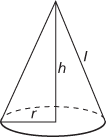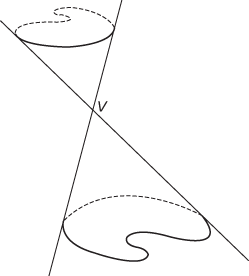1. (in optics) A type of light-sensitive receptor cell, found in the retinas of all diurnal vertebrates. Cones are specialized to transmit information about colour and they function best in bright light. They are not evenly distributed on the retina, being concentrated in the fovea and absent on the margin of the retina. Compare rod.
2. (in mathematics) A solid figure generated by a line (the generator) joining a point on the perimeter of a closed plane curve (the directrix) to a point (the vertex) outside this plane, as the line moves round the directrix. If the directrix is a circle, the figure is a circular cone standing on a circular base. If the line joining the vertex to the centre of the base (the axis) is perpendicular to the base the figure is a right circular cone, which has a volume πr2h/3, where r is the radius of the base and h the height of the vertex above the base. If the axis of the cone is not perpendicular to the base, the figure is an oblique cone. In general, the volume of any cone is one third of its base area multiplied by the perpendicular distance of the vertex from the base.
A circular cone has a circle (radius r) as base, a vertex lying at height h directly above the centre of the circle, and the curved surface formed by the line segments (length l, the slant height) joining the vertex to the points of the circle. The cone’s interior has volume and the area of the curved surface equals π rl.
More generally, a cone is the surface consisting of the points of the lines, called generators, drawn through a fixed point V, the vertex, and the points of a fixed curve. The generators may be extended indefinitely in both directions to form a double cone. See also quadric cone.

A right circular cone

A double cone over a curve
1. (in botany) A reproductive structure occurring in gymnosperms, known technically as a strobilus. It consists of sporophylls bearing the spore-producing sporangia. Gymnosperms produce different male and female cones. The large woody female cones of pines, firs, and other conifers are made up of structures called ovuliferous scales, which bear the ovules. Cones are also produced by clubmosses and horsetails.
2. (in animal anatomy) A type of light-sensitive receptor cell, found in the retinas of all diurnal vertebrates. Cones are specialized to transmit information about colour (see colour vision) and are responsible for the visual acuity of the eye. They function best in bright light. They are not evenly distributed on the retina, being concentrated in the fovea and absent on the margin of the retina. Compare rod.
- Sakmarian
- sakti
- Saladin (1137–93)
- Salam, Abdus
- Salam, Abdus (1926–96)
- salamander
- salami attack
- Salamis, Battle of (480)
- sal ammoniac
- salary
- Salazar, Antonio de Oliveira (1889–1970)
- SALC
- salcrete
- Salem witch trials (1692)
- sales force automation
- sales tax
- salic
- salic horizon
- Salic law
- salicylic acid
- salina
- salination
- saline
- saline giant
- saline-sodic soil